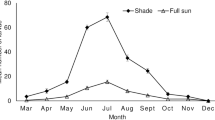Summary
Larvae of Platyprepia virginalis (Lep.: Arctiidae) and Orgyia vetusta (Lep.: Lymantriidae) feed on the foliage of bush lupine (Lupinus arboreus Sims) at Bodega Bay, California, USA, in February–April and May–July, respectively. Female O. vetusta attained lower pupal weights and produced fewer eggs on branches of L. arboreus which had experimentally received P. virginalis damage earlier in the same year, compared to those reared on control branches.
Growth rates of first-instar O. vetusta were lower on undamaged leaves of previously damaged L. arboreus than on leaves of undamaged controls. This was true for lupine bushes damaged by P. virginalis in the field; and also for greenhouse-grown lupine plants damaged by Estigmene acrea (Lep.: Arctiidae) when excised foliage was used in the assay. However, fifth (last) instar female O. vetusta larvae showed no preference for damaged versus undamaged greenhouse-grown L. arboreus in their feeding or choice of a site for pupation.
These experiments demonstrate the potential for competition-like interactions between herbivores mediated by changes in quality of the shared host.
Similar content being viewed by others
References
Anderson RM, May RM (1980) Infectious disease and population cycles of forest insects. Science 210:658–661
Andrewartha HG, Birch LC (1954) The Distribution and Abundance of Animals. Chicago: University of Chicago Press
Baltensweiler W, Benz G, Bovey P, Delucchi V (1977) Dynamics of larch budmoth populations. Ann Rev Ent 22:79–100
Beckwith RC (1975) Influence of host foliage on the Douglas-fir tussock moth. Envir Ent 5:73–77
Cain ML, Eccleston J, Kareiva PM (1985) The influence of food plant dispersion on caterpillar searching success. Ecol Ent 10:17–7
Davidson ED (1975) Demography of bush lupine, Lupinus arboreus at Bodega Head, Calif. Ph.D. thesis, Ecology, U.C. Davis
Denno RF, McClure MS (1983) Variable Plants and Herbivores in Natural and Managed Ecosystems. New York: Academic Press
Faeth SH (1986) Indirect interactions between temporally-separated herbivores mediated by the host plant. Ecology 67:479–494
Ferguson DC (1978) The Moths of America North of Mexico. London: E.W. Classey
Fowler SV, Lawton JH (1985) Rapidly induced defenses and talking trees: the devil's advocate position. Amer Nat 126:181–195
Furniss MM, Knopf JAE (1971) The western tussock moth. United States Forest Service, Forest Pest Leaflet no. 120
Gere G (1964) Change of weight, lipid and water content of Lymantria dispar L. with special regard to the chemical and energetic changes during insect metamorphosis and imaginal life. Acta Biol Hung 15:139–170
Hairston NG, Smith FE, Slobodkin LB (1960) Community structure, population control and competition. Amer Natur 115:354–366
Haukioja E (1980) On the role of plant defenses in the fluctuation of herbivore populations. Oikos 35:202–213
Haukioja E, Neuvonen S (1985) Induced long-term resistance of birch foliage against defoliators: defensive or incidental? Ecology 66:1303–1308
Holt RD (1977) Predation apparent competition and the structure of prey communities. Theor Pop Biol 12:197–229
Karban R (1986) Interspecific competition between folivorous insects on Erigeron glaucus Ecology (in press)
Karban R, Carey JR (1983) Induced resistance of cotton seedlings to mites. Science 225:53–54
Kogan M, Paxton J (1983) Natural inducers of plant resistance to insects. In: Plant Resistance to Insects, Hedin P (ed), Washington D.C.: American Chemical Society, pp 153–172
Lawton JH, Hassell MP (1985) Asymmetrical competition in insects. Nature 289:793–795
Lawton JH, Strong DR (1981) Community patterns and competition in folivorous insects. Amer Natur 118:317–338
Neuvonen S, Haukioja E (1981) How to study induced plant resistance? Oecologia (Berlin)
Raupp MJ, Denno RF (1984) The suitability of damaged willow leaves as food for the leaf beetle, Plagiodera versicolora. Ecol Ent 9:443–448
Renwick JAA (1983) Nonpreference mechanisms: Plant characteristics influencing insect behavior. In: Plan Resistance to Insects, Hedin P (ed) Washington D.C.: American Chemical Society, pp 199–214
Rhoades DF (1983) Responses of alder and willow to attack by tent caterpillars and webworms: Evidence for pheromonal sensitivity of willows. In: Plant Resistance to Insects, Hedin P (ed). Washington D.C.: American Chemical Society, pp 55–68
Rhoades DF (1985) Offensive-defensive interactions between herbivores and plants: their relevance to herbivore population dynamics and community theory. Amer Natur 125:205–238
Rosenthal GA, Janzen DH (1979) Herbivores: Their Interactions With Secondary Plant Metabolites. New York: Academic Press
Schoener TW (1983) Field experiments on interspecific competition. Amer Natur 122:240–285
Schultz JC, Baldwin IT (1983) Oak leaf quality declines in response to defoliation by gypsy moth larvae. Science 217:149–151
Smith NG (1983) Host plant toxicity and migration in the dayflying moth Urania fulgens. Florida Entomol 66:76–85
Sokal RR, Rohlf FJ (1981) Biometry (2nd ed.). San Francisco: Freeman
Strong DR, Lawton JH, Southwood TRE (1984) Insects On Plants: Community Patterns and Mechanisms. Cambridge: Harvard University Press
Tietz HM (1972) An index to the described life histories, early stages, and hosts of the Macrolepidoptera of the United States and Canada. Sarasota, Fl.: Allyn
Valentine HT, Wallner WE, Wargo PM (1983) Nutritional changes in host foliage during and after defoliation, and their relation to the weight of gypsy moth pupae. Oecologia (Berlin) 57:298–302
Williams KS, Myers JH (1984) Previous herbivore attack of red alder may improve food quality for fall webworm. Oecologia (Berlin) 63:166–170
White TCR (1974) A hypothesis to explain outbreaks of looper caterpillars with special reference to populations of Selidosema suavis in plantation of Pinus radiata in New Zealand. Oecologia (Berlin) 16:279–301
White TCR (1978) The importance of a relative shortage of food in animal ecology. Oecologia (Berlin) 33:71–86
White TCR (1984) The abundance of invertebrate herbivores in relation to the availability of nitrogen in stressed food plants. Oecologia (Berlin) 63:90–105
Author information
Authors and Affiliations
Rights and permissions
About this article
Cite this article
Harrison, S., Karban, R. Effects of an early-season folivorous moth on the success of a later-season species, mediated by a change in the quality of the shared host, Lupinus arboreus Sims. Oecologia 69, 354–359 (1986). https://doi.org/10.1007/BF00377056
Received:
Issue Date:
DOI: https://doi.org/10.1007/BF00377056




